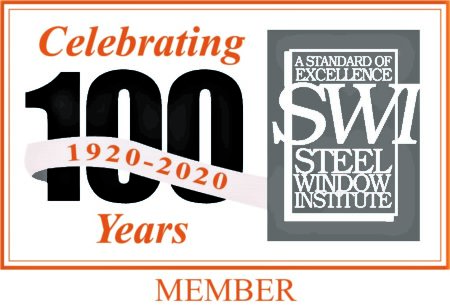FAQ
These questions and answers are meant to be general in nature.
Please contact Optimum Window Mfg. Corp. for specific information about steel windows and doors.
Hot-rolled steel windows and doors are made from solid steel sections, which are produced from new billet steel into shapes specifically designed for window and door frames and also ventilators. Cold-rolled steel windows and doors are made from hollowed steel sections, which have been mechanically formed from flat coil stock into specifically designed profiles.
Steel windows and doors are custom manufactured on a project-specific basis and are often chosen for their ability to fill very large openings while maintaining narrow sight lines. Due to the inherent strength of steel, steel windows and doors can be made as large as or larger than any other conventional window and door system available.
The inherent strength and durability associated with steel windows and doors results in a product that outperforms any other window material – aluminum, wood fiberglass or vinyl.
Hot-rolled steel and cold-rolled steel windows are manufactured from 100% recycled steel. Our aluminum series is also made of recycled materials.
No, with the advances in insulated glass and the ability of steel windows to accept insulated glass, a thermal break is not required. In addition, the end user may control the relative humidity reducing the potential for condensation using existing climate controls.
The condensation resistance factor (CRF) of steel windows and doors will vary depending on the size and configuration of the unit; as well as the type of glass. Consult OWM sales staff for specific information.
Yes, steel windows and doors are thermally efficient. As an example, the thermal resistance of steel is 5 times greater than that of aluminum. The strength of steel affords narrow sight lines, thus reducing the ratio of glass to framing. The more glass there is in a window or door, the better the U-value.
U-values vary depending on the type and thickness of glass used. The U-value for steel windows is calculated for the entire window, including frame material and the glass; and then will incorporate the style of window; fixed or operable. The U-value can be either physically tested or simulated with a computer program. The combination of the minimal framing profiles of steel, the low coefficient of heat transfer, and larger glass areas will produce U-values as low as 0.26 for fixed windows; while operable windows can be as low as 0.42.
Pre-treatment options include marine galvanization, zinc-enriched primer & E-coat upon request. Finish paints include enamels, polyurethane, & powder coat paints. Consult OWM’s sales staff for more specific information.
A paint finish with minimal amount of care can last 10-15 years. Minimal care consists of washing the frames twice a year. (See OWM’s Maintenance Manual)
No. Paint finishes prevent any corrosive interaction between dissimilar metals.
Steel windows and doors are typically glazed using glazing tape, glazing wedge, setting blocks, custom pre-fitted glazing beads and a cap bead of sealant on the exterior.
Steel windows can accommodate glass thicknesses ranging from 1/8″ to 1-1/2″, including single pane, laminated or leaded glass, including most any of the high performance insulated glass products currently available.
Steel windows are generally provided with continuous snap-in glazing beads which can be easily removed to replace the broken glass and reinstalled with new glazing materials.
Due to the large custom sizes of steel windows and doors, ease of handling and installation makes field glazing more practical.
In the event of a fire, egress windows provide an opening large enough to allow occupants to escape; or to allow a fully-equipped firefighter to enter from the outside. The International Building Codes (IBC) specify the minimum clear opening width for an egress window at 24 in.; the minimum clear opening height is 20 in., and the net clear opening requirement is 5.7 sq. ft. To comply with the codes, an egress window must be set with a maximum sill height of 44 in.
Absolutely! Please contact Optimum for available designs.
Yes. The windows can easily be limited to the required clear opening restriction, yet can be released for cleaning.
Magnetic and wicket screens are available.
Fire-rated windows are used in window openings where it is necessary to restrict the spread of fire within buildings, whether from interior fire or exterior fire. Steel fire-rated windows are available in fixed, casement, projected, vertical sliding, and horizontal sliding configurations. Steel doors are also available for fire-rated applications.
Fixed, Project-In, Project-Out, Side Hung-Out, Side Hung-In, Vertical Slider, Horizontal Slider, and Pivoted.
Out-Swing, In-Swing, Bi-Fold, Sliding, and Pivoted.
To ensure the best performance of steel windows, proper installation is critical. Please ensure that an experienced steel window installer & glazier are utilized. OWM will provide our ‘Installation Manual’ upon request.
Yes, however, with the advancement of today’s technology, it would be impossible to compete with the performance, paint, hardware, energy codes & warranties of current steel window applications.
There is a wide range of window and door products available in the marketplace. Therefore, to obtain true comparatives between steel and other window materials, contact an OWM representative.
It is important for buyers and specifiers of steel windows to know that these products can meet and exceed the required performance standards and codes. Steel windows are tested to ASTM E283 (Air), ASTM E331 (Water), and ASTM E330 (Structural/Uniform load). Other specialty performance testing could include impact, hurricane, fire-rating, thermal, blast, ballistic, acoustic, etc.
Optimum offers various pre-treatment paint and hardware depending on the application. Consult Optimum for specific recommendations relative to care and maintenance.
*Maintenance manual available upon request.



